This week I am going to go over several small points instead of tackling one thing. I hope you enjoy it!
Red/White Recap
I still love the R/W deck from last week.
I played it in my Deckade Book Signing Standard tournament. In the real world, even when you have Josh Ravitz and Tony Tsai, sometimes you just don’t have enough Flames of the Blood Hand; Mark Young trains it up all the way from the Southern Hemisphere and barns you some, and you still don’t have enough. So when I say I played “it,” I mean I played almost “it,” (“it” being “the R/W deck”) and in fact had to cram a Hidetsugu’s Second Rite into the main, which was a combination of comedic and oddly successful.
I ended up losing to Billy Moreno and The Beautiful Struggle mmyoung. Billy had no deck, so young Steve Sadin lent him our G/W from the PTQs… If there’s one deck that the R/W can’t beat, it’s the G/W. I still managed to steal game 1.
Against mmyoung, I played exactly the game I wanted, got him to tap out exactly the turn I wanted, and sculpted the flow of the game so that he would be vulnerable and on precisely ten life when I had mised the Hidetsugu’s Second Rite in game 1. All I needed to do was draw a fourth land after missing on three straight pulls… Alas, I didn’t. Mark bingoed the UrzaTron the next turn, and when I actually got my fourth land, he had mana to Electrolyze himself and essentially seal it. Mark was impressive in that he declined my draw offer (I asked why maintain the Beautiful Struggle when one could take the Path of Least Resistance).
I wouldn’t normally complain about x-2 not making the break, but what seemed like half the Top 8 had that record (it was weird because of draws, with not a single x-1), so I just ended up being screwed on breakers at my own tournament.
Some of you listen to the weekly radio show BDM and I put out, and have had some profitable results (I’m looking at you, Pselus). Following my Top 8 miss, this is an example of what I sound like without Brian reining me in. Listen at your own risk.
The Top 8 was largely decks I thought I could beat, especially with my new sideboard, so (insert whatever sundry complaints come to mind when you get screwed on breakers).
Anyway, despite the near miss on Saturday, I’ve not lost a game in the 8-man Queues with R/W since switching up the sideboard, with “not losing a game” equal to a single 3-0/6-0 Queue victory (which still counts! technically!). In case you hadn’t gleaned it yet, the fundamental shift involved bogarting Hidetsugu’s Second Rite from Clan Cymbrogi (thanks guys), who talked it up in last week’s forums. I beat Heartbeat 2-0 in the Deckade Swiss and haven’t lost to it online yet. I also did a set of testing with “Manning Bot” Asher, who finished 3rd-4th at the Deckade Standard with Heartbeat, and is one half of the current New York State Champions (in Two-Headed Giant competition), with R/W winning nearly every game.
Without further preamble, here is my current R/W listing (i.e. what I’ve been playing on MTGO):
Creatures (20)
Lands (20)
Spells (20)
Sideboard

At the Deckade tournament, I ran two Pithing Needles in the sideboard, but Josh and I agree that you want 8.5 in so many matchups, and that you just want to draw Second Rite against Heartbeat, that you should just play four copies of each and forget about the stupid Pithing Needles; as with Gruul Deck Wins, Pithing Needle just doesn’t do any damage, and I hate cards that don’t do any damage in burn decks.
It takes a bit of getting used to, playing Hidetsugu’s Second Rite as part of a burn deck strategy… You will often have to bait the opponent differently, and represent the value of your cards in heretofore undiscovered ways, but the rewards – particularly in the face of Loxodon Hierarch or combo decks – can’t be exaggerated. In a word: surprise!
My general conclusion is that the proper Team PTQ setup should (still?) be Heartbeat, G/W (Cali version), and R/W; I am not certain if R/W is the best deck in Standard, but it doesn’t have many bad matchups… The G/W matchup is basically impossible in the absence of beaucoup trickery, but I would be happy to play against Heezy Street (with or without Silhana Ledgewalker), Zoo (hopefully without Billy’s Glare of Subdual board strategy), most control decks, and definitely Heartbeat and B/W aggro (though Ghost Dad less so) all day in a PTQ setting or individual tournament (this deck is basically all I ever use in MTGO right now).
Deckade Gauntlet
The big draw of the Deckade event was the Gauntlet. I just want to thank my friends from coming out of the woodwork to support the book and have fun playing completely unfair Magic for a day. BDM and I are going to have more “coverage” up, including deck lists, more photos, and that kind of stuff, but I thought I’d share a couple of pictures from the event just to make you jealous that you didn’t show (idiot).
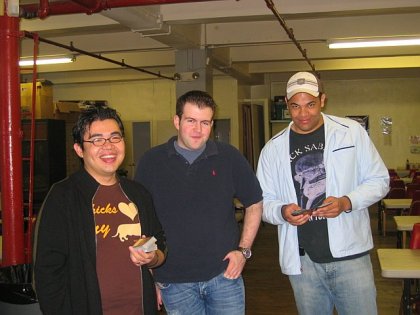
According to McKeown and BDM, you can call us “Team Flogit.”
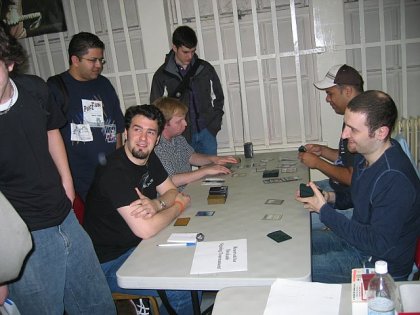
Luis (playing Jonathan Magic) and mmyoung (playing Joe Black) both made Top 8 of the Deckade Standard tournament; Jonny and Osyp kept my foils safe during the Gauntlet, while the rest of us gave up many a game.
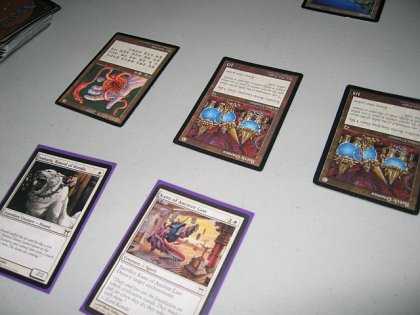
To give you an idea of the “unfair” nature of the Gauntlet, we all played old decks versus current Standard decks. I played this States 1998 Top 8 Draw-Go deck unsleeved (I was something like 6-0 versus Academy that year! Yahoo!)… My first Gauntlet opponent beat a multiple Bottle Gnomes and Nevinyrral’s Disk draw with – you guessed it – my own R/W from last week’s article! He made sure to tell me so!
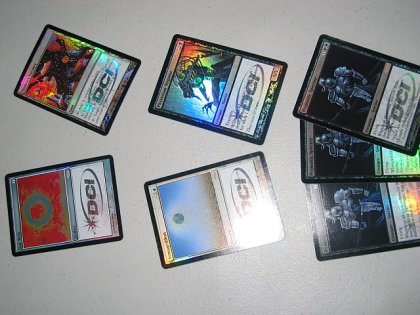
Here are some of the prizes we gave away.

Probable Hall of Fame inductee Steve OMS can’t be bothered to show up for a Pro Tour, but damn if he didn’t come for a day of Deckade celebration!

This fashion plate does it all… Casts Naturalize with Blue mana, keeps a man out of his own tournament’s Top 8, and dazzles the ladies with a wardrobe second only to edt’s.
Like I said, more to come from BDM.
Reading Opponents on MTGO
John Shuler and I used to talk about reading poker opponents online. John maintained they could be read and I said something like “if it takes a long time for someone to call, how do you know he wasn’t just going to the toilet?” or some such.
In the real world, my memorable bad plays are made even more horrendous in context by the fact that I am actually quite good at reading my opponent. It’s one thing to screw up, but to screw up when you have figured out what is in your opponent’s hand is just plain embarrassing. I don’t have that skill online because of the nature of the interface… but sometimes the opponent just hands the game to you, and you’ve got to be fairly stupid not to take it when they do so.
In the 8-Man I played on Tuesday night, I was up a game against B/U mid-range and kept a one land hand on the draw (Battlefield Forge). I stopped on one for three turns. In the course of my slow development this game, the following occurred: I had two Savannah Lions eat it to two Ribbons of Night; I got hit in the face with Hypnotic Specter no less than three times (one of which nabbed my Hand of Honor); my opponent acquired at least six counters on his Umezawa’s Jitte (and probably eight).
What do you mean? Of course I won. In fact, it wasn’t particularly close.
In the very late game, I looked at my hand, looked at my six mana (he had ten-plus), and fired off Volcanic Hammer and Char for the win… Despite the fact that my Blue opponent had a hand. He had been cursing the whole game (you know the kind of chats that have long spaces between words that end in ” ing” or so). According to him, I was not only “lucky” (did the above description seem lucky to you?), but I played so that I would immediately ” ing” lose to ” ing” Mana Leak (I had nine life and didn’t feel like I would be losing any time soon versus a naked Jitte and no guys). We have all experienced opposing players complaining, but in this case, that’s not the point: He told me in no uncertain terms that he didn’t have the Mana Leak.
No fewer than three of the opponent’s Jitte counters were spent gaining two life in situations where there was no lethal damage on the stack, no effect whatsoever in at least one case. Against a mana-light opponent, resource strapped, and buffetted by a Hypnotic Specter no fewer than three times… Is this how someone gripping Mana Leak would behave? Moreover, I played burn cards with two or fewer lands left up to eliminate creatures, just to bleed Jitte counters or try to prevent too many counters from being accumulated. If he’d had Mana Leak, don’t you think he would have used it?
The kicker – more than his stream of curses, which may actually have been a ruse – was the fact that he played land for three consecutive turns when we were both in topdeck mode. Had he just hoarded those lands as a bluff, I would have been much more conservative in my play.
Here are some guidelines to give you some small edge in the MTGO mental game:
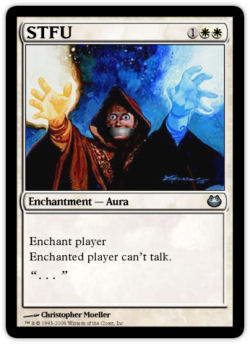
1) Don’t say anything.
I know it’s hard. Last night I drafted a great R/W deck in MMV with a million good drops, two copies of the best trick, and two Fireblasts, and felt ready to go 3-0/6-0. In the first round I kept a two lander with three flankers in my hand and just discarded the entire game without ever making a play. Not even one. I won the second easily, but lost in a six spell/eleven land third, where I made a five star swindle and had him dead the next turn. And his deck was awful.
0-1.
I know it’s hard. Don’t. Say. Anything. If my opponent hadn’t complained so much, I might have held the Char… It’s really hard to be a good liar on MTGO, as opposed to real life Magic where you have eye contact and body language on your side. You actually have to make the plays (and, let’s be honest, avoid the misclicks) in the digital world.
Also there’s the issue of sportsmanship. And yes, I know it’s hard.
2) Focus on what’s important.
This is the exact same as in paper Magic. Don’t spend your cards on tangents. If you already have seven lands in play and you’re in topdeck mode and your most expensive card costs maybe five, don’t keep playing lands… All you are doing is giving the opponent free information.
First Thoughts on Dissension Draft
I know, I know, you’ve probably never read a word of Limited theory by me. Before you skip to the next section, let me just point out that I’ve won more Limited PTQs than Constructed, and that immediately preceding the five or so year interregnum where I didn’t attend many premiere events, I was a Top 20 DCI Limited player (whatever that means). Also, feel free to check out BDM’s notes on my early Ravnica card valuations from last week before you dismiss (I’m perfectly willing to admit I missed Vedalken Dismisser, though).
These are 80/20 Rule guidelines, and by buddy Jon would caution you to never adhere too hard and fast to any such rules in Magic… But anyway, these are the ones I’m going to start with, given that nobody knows how to draft Dissension in three-set-Limited perfectly quite yet.
As a baseline, I think you should draft Boros or Dimir first pack, possibly Golgari (yuck), and generally avoid Selesnya.
I know many people don’t like Boros at all, but 2/3 of my good drafts are R/W with up to five Boros Fury Shields, two of which I took first or second, two of which I got 13th or later, so I’m biased. For everybody else… Why draft in this direction?
Check out these flows I set up over three packs:
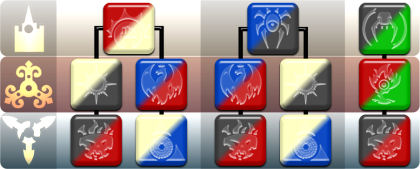
Basically, you can go BRW, URW, BUR, BUW, or BGR and draft Guild all three packs; all five of these options are synergistic in their own ways (e.g. BRW comprises the three Guilds that all want the same thing: to disrupt, destroy, and pummel the opponent). If you go Selesnya, you get a choice between Orzhov and Gruul in Guildpact, but hit a Guild dead end in pack three. This also means there is no clean line to Simic (or, alternately, those who want to take Siege Wurm over Galvanic Arc are likely going to have to go four color – which Green decks are fine at doing in this format, mind you – or hope for a ton of good non-aligned picks in one of the three packs). Again, it seems like if you want to go Selesnya, Simic, and/or polychromatic Green, you will have to value your one pack of Civic Wayfinders and Farseeks quite a bit.
Just to address any potential dissenting opinions on the forums before they actually see print, I’d just want to point out one thing: When you qualify for the Pro Tour with Suicide King in a format full of Forbidian and High Tide, you can thank your lucky stars for the format full of Forbidian and High Tide, because Suicide King might not be a very good choice in a pre-equilibrium, unevolved, early metagame; in the Queene’s Ingrish, what I mean is that there is no real reason to “drafto roguo” outside a framework like the one presented here (there being no real rogue without a perceived metagame); it simply seems like you get more chips in the early weeks by focusing color picks and eliminating distracting options to some tune like the five presented here. Or put another way, you can theoretically pick Selesnya first and reap BOTH Azorius and Simic in Dissension as a UGW mage… but while your third pack offers up conflicting playables, you will have to scrape a bit in Guildpact.
The last, and possibly most compelling reason why I think this model makes sense, especially with Prerelease weekend coming up, is that you get three packs of in-Guild Karoos. At Finkel draft you take Karoo second or you don’t get one; in-color Karoos are a heck of a lot better than splash Karoos.
Side Note on Draft Mastery:
Late one night at Pro Tour Honolulu, Kenji Tsumura espied one of my forty-card decks and proclaimed me a “mastah” (probably the highlight of my year 2006 thus far) while Katsu Mori asked if I planned to draft that well at the Invitational. Why? In addition to twenty-odd other good spells, I had four Steamcore Weirds! How did I get these? Easy, I played the metagame.
When we went to sit for the draft I positioned myself to the left of Mike Turian. Now normally you would never want to be to the left of Mike Turian… Even a couple of years removed from the Pro Tour, Mike has to remain one of the top five or so Limited players of all time, and may still be the world’s finest team drafter… Why in the name of all that is holy would I want to be to Mike’s immediate left?
We New Yorkers brought “Finkel house rules” with us to Honolulu, which, unlike “traditional” team draft rules (where opponents alternate table seating), state that you wager (if at all), you sit, and only after the draft do you randomly determine teams. I was no more likely to play against Mike than if I had sat across him instead; all I got for my forced position was two packs of guaranteed Blue goodness while the mighty potato scooped up all the hated Green cards.
End Side Note.
Son of a Cow
This week, the lcd_cow Richard Feldman posted a primer on his Enduring Ideal deck. His Honolulu-unsuccessful implementation got my gears turning, so I decided to try my hand at the same (but, hopefully, with better cards).
Lands (25)
Spells (35)
- 1 Genju of the Realm
- 4 Wrath of God
- 4 Fellwar Stone
- 4 Peer Through Depths
- 2 Form of the Dragon
- 1 Ivory Mask
- 2 Seething Song
- 1 Zur's Weirding
- 1 Confiscate
- 4 Enduring Ideal
- 3 Faith's Fetters
- 4 Telling Time
- 4 Izzet Signet
Sideboard

Creatures (11)
Lands (22)
Spells (27)

Incentives and Threat, and Manipulation Balance
I won’t go through all the versions of the deck that I tried in the MTGO Tournament Practice room (Jittes, different land counts, and so forth)… I’ll just comment on this one. I have almost the exact same Enchantments-driven threat base that Richard plays and all of his defense (Faith’s Fetters into Wrath of God), but I also have a reasonable creature-control deck… that is probably good enough to run with a lot of the creature decks in the format. I lack the one Genju of the Realm, but make up for it with Yosei, Loxodon Hierarch, and the arguably superior offensive card given the nature of Epic cards, Debtors’ Knell.
My deck, despite playing two distinct plans, actually has more acceleration. I originally matched Richard’s eight Signets with eight Green two mana plays, but the 4th Kodama’s Reach seemed better than the 4th Farseek when I crammed Debtors’ Knell into the mix.
As for deck manipulation, Richard has four Peer Through Depths, four Telling Time, and four Enduring Ideal. My accelerators double up on manipulation, and Sensei’s Divining Top matches one class of Richard’s eight two mana dig cards… but is better long run because of the shufflers and ability to dodge drawing an uncastable enchantment.
On top of all that, my deck has a soft lock in Miren/Yosei/Debtors’ Knell. My first Ideal target tends to be the Knell, which I use to set up life or Winter Orb/Dragon loops.
Improved Sideboard and Multiple Avenues of Attack
Besides having a more proactive maindeck, the main incentive to going from U/r/W to u/G/r/W is my sideboard. Unlike Richard, whose board plan is to add seven mostly worthless permission cards, I can actually board into a different deck. Against Cranial Extraction (for Enduring Ideal), I can go into 80% of a States Greater Good deck, with both Gleancrawler and Debtors’ Knell providing the long-term moxie. Or against non-Black permission decks, I can go balls-out Ideal with all the Boseijus in, adding enchantments as the matchup dictates.
The Parallectric Feedbacks (and commensurate trinity of Red sources in the main) came late from the forums, as an anti-Heartbeat measure. Initially I thought they were terrible – and my team-mate Paul Jordan beat any number of Feedbacks in the PTQ season – but alongside three sideboarded Boseijus? Hey… It’s worth a try! With Heartbeat being maybe the worst game 1 matchup, the devotion of four distinct cards seemed reasonable, especially as they also work against URzaTron’s Blaze in a pinch.
Opportunity Costs
This version is slightly less focused on JUST getting the Ideal off. It lacks some amount of Ideal redundancy (no Dream Leash or Genju access), and it doesn’t have room to play the B/W hating Privileged Position in the main (as Richard suggested but didn’t actually play). On balance, I think it is probably a better deck, although I haven’t tested to enough of an extent to make that claim official.
Matchups
In between taking bad beats in MMV and playing some Standard Queues, I’ve knocked the Hybrid Ideal around in the Tournament Practice room with a bit to report. The beatdown matchups seem fine if uninspiring. The typical B/W deck just seems behind, even if its cards are serviceable… the same way Ghost Dad might be behind a transformed Heartbeat deck after it has taken out all the Sickening Shoals and Pillories for Cranial Extractions.
Vore is an odd matchup; I’ve both won and lost it in two. Vore can’t really contain all the mana fixing in this deck, even with its meager 22 lands, but it can work an Eye of Nowhere in such a way as to make Faith’s Fetters or Wrath of God too clumsy against a, say, 10/10 Magnivore. When I win it’s because my opponent is trying to play a land destruction deck (that, or I played Zur’s Weirding with my fingers crossed); when I lose, it’s because he plays like Steve.
Heartbeat seems like a dismal matchup… Like I wouldn’t win even if I “went off,” let alone just tried to attack with creatures. The fourth color in the sideboard is an attempt to reconcile that. If this deck ends up being worth talking about, I’ll either update on the Feedbacks or tell you to spend those slots on something more general.
Despite varied results, I don’t think Hybrid Ideal is a bad choice at all, and I might be willing to fight a bit in the 8-Man Queues with it because of the B/W matchups (and creatures in general). When I lose, it’s usually to weird stuff, like U/W Zur’s Weirding beatdown or U/R infinite Izzet Guildmage… stuff where I have no realistic opportunity to interact, at least past the first Ideal copy.
After this weekend, Simic lands probably make this deck better… but when Dissension comes, who knows if it will still be worth talking about?
One Paragraph on Team Seating
My first round of Team PTQ advice talked about our placing Vore in the B to fight control decks. After a few weeks of additional data, my new idea is that teams should put the best player with the fastest deck on B instead of the best player with some slow control deck (follow or metagame against this recommendation as you will). The idea is that with a fast deck, this player will have the most time to coach his team-mates after completing each of his seven minute matches.
Next Week: Dissension Reviews Begin!
LOVE
MIKE
